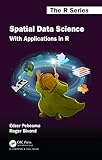Spatial data science : with applications in R / Edzer Pebesma and Roger Bivand.
Material type: TextSeries: Chapman & Hall/CRC Press the R seriesPublication details: Boca Raton: CRC Press, Taylor & Francis Group, 2023.Edition: First editionDescription: xiv, 300p.: ill. (col.) 23cmISBN:
TextSeries: Chapman & Hall/CRC Press the R seriesPublication details: Boca Raton: CRC Press, Taylor & Francis Group, 2023.Edition: First editionDescription: xiv, 300p.: ill. (col.) 23cmISBN: - 9781138311183
- 9781032473925
- 519.5/3502855133 23/eng20230331
- QA278.2 .P43 2023
| Item type | Current library | Call number | Copy number | Status | Barcode | |
|---|---|---|---|---|---|---|
 Books
Books
|
Zetech Library - Mang'u Campus General Stacks | QA278.2 .P43 2023 (Browse shelf(Opens below)) | Available | Z012380 | ||
 Books
Books
|
Zetech Library - Ruiru Campus General Stacks | QA278.2 .P43 2023 (Browse shelf(Opens below)) | C2 | Available | Z012624 |
Includes bibliographical references and index.
Part 1. Spatial Data 1. Getting Started 2. Coordinates 3. Geometries 4. Spherical Geometries 5. Attributes and Support 6. Data Cubes Part 2. R for Spatial Data Science 7. Introduction to sf and stars 8. Plotting spatial data 9. Large data and cloud native Part 3. Models for Spatial Data 10. Statistical modelling of spatial data 11. Point Pattern Analysis 12. Spatial Interpolation 13. Multivariate and Spatiotemporal Geostatistics 14. Proximity and Areal Data 15. Measures of spatial autocorrelation 16. Spatial Regression 17. Spatial econometrics models Appendix A. Older R Spatial Packages
"Spatial Data Science introduces fundamental aspects of spatial data that every data scientist should know before they start working with spatial data. These aspects include how geometries are represented, coordinate reference systems (projections, datums), the fact that the Earth is round and its consequences for analysis, and how attributes of geometries can relate to geometries. In the second part of the book, these concepts are illustrated with data science examples using the R language. In the third part, statistical modelling approaches are demonstrated using real world data examples. After reading this book, a number of major spatial data analysis errors should no longer be made because of lack of knowledge. The book gives a detailed explanation of the core spatial software packages for R: sf for simple feature access, and stars for raster and vector data cubes - array data with spatial and temporal dimensions. It also shows how geometrical operations change when going from a flat space to the surface of a sphere, which is what sf and stars use when coordinates are not projected (degrees longitude/latitude). Separate chapters detail a variety of plotting approaches for spatial maps using R, and different ways of handling very large vector or raster (imagery) datasets, locally, in databases, or in the cloud"--
There are no comments on this title.

